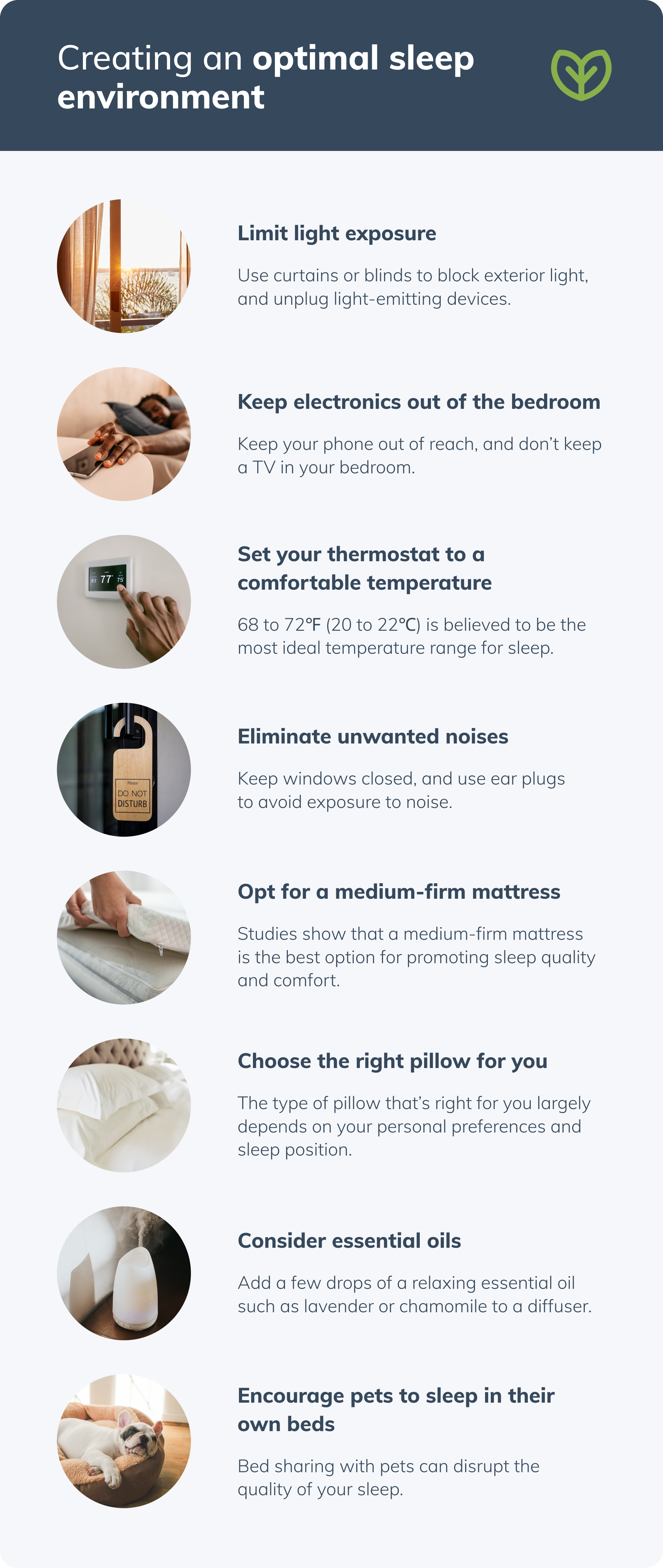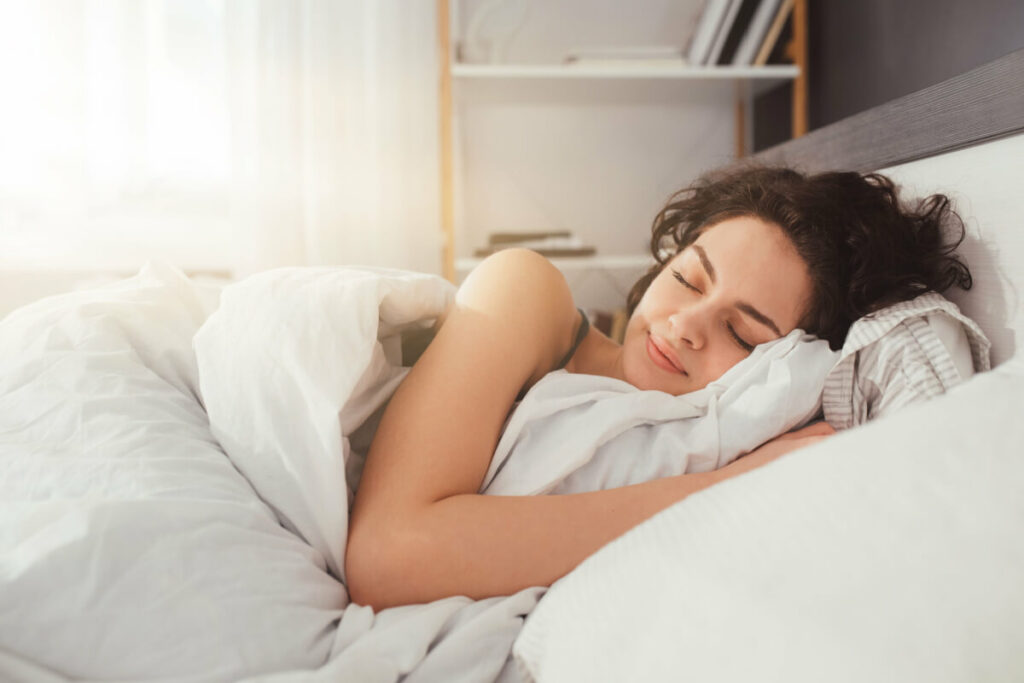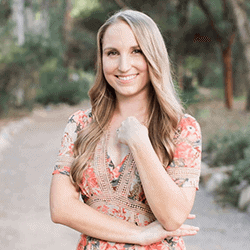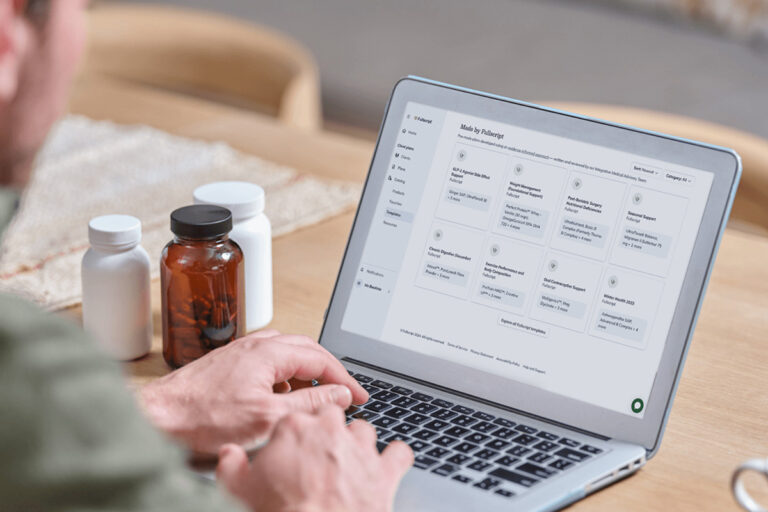Is your bedroom set up to foster relaxation and restful sleep? Creating a calm, quiet space in your bedroom can have a positive effect on the duration and quality of your sleep.
Getting enough restful sleep is a common struggle—over 35% of adults report sleeping less than the recommended seven hours per night, and between 10 and 30% of adults struggle with insomnia, an inability to sleep. (23) Lack of sleep can have immediate effects on your energy levels, brain function, and overall well-being, but that’s not all—chronic (long-term) insufficient sleep is linked to the development of many chronic health conditions such as type 2 diabetes, heart disease, and depression. (5)
Optimizing your bedroom for a better night’s sleep doesn’t need to be complicated or expensive. Continue reading to learn some of the top evidence-based tips for creating a calming environment to help you achieve your best sleep yet.
8 tips for creating an ideal sleep environment
Outlined below are some of the best ways to improve your bedroom’s surroundings to get better sleep.

1. Limit light exposure
One of the easiest and most effective ways to improve your sleep environment is to limit exposure to light. Research indicates that exposure to light in the late evening suppresses melatonin levels, a hormone that regulates sleep-wake cycles. (8) Reduce light exposure by:
- Removing alarm clocks with bright lights
- Turning off bright overhead lights in your bedroom and opting for dim ambient lighting in the hours before bedtime
- Unplugging night lights
- Using room-darkening shades or blackout curtains to block out exterior lighting
- Wearing an eye mask (4)(7)
2. Keep electronics out of the bedroom
Televisions, smartphones, and other electronics emit blue light, the same type of light that is emitted by the sun. Evening exposure to artificial blue light from your electronic devices can trick your brain into thinking that it’s daytime, making it more difficult to fall asleep. (25) Store your phone and other devices outside of your bedroom, or keep them out of reach from your bed.
Tip: Consider wearing blue light-filtering glasses while using electronic devices and for the two hours leading up to bedtime. One study showed that individuals who wore blue light glasses had higher levels of melatonin and were more likely to fall asleep faster. (22)
If you have a television in your bedroom, consider relocating it to another room. Research demonstrates that sleeping in the same room as a television can shorten sleep duration. One study noted that children who slept in rooms with televisions reported sleeping 18 minutes less than children who didn’t have TVs in their room. (6)

3. Set your thermostat to a comfortable temperature
The temperature of your bedroom is one of the most influential factors on the quality of your sleep–that’s because your body’s internal clock, known as the circadian rhythm, is affected by your core body temperature. (15) Current scientific literature suggests that the ideal room temperature for sleeping is between 68 and 72℉ (20 and 22℃).
Ultimately, it’s important to find a temperature that you find most comfortable, and keep in mind that your preferences can be influenced by various factors such as the current season, the type of clothing you’re wearing, and the weight of your bedding. (15)
Did you know? Wearing socks to bed when temperatures are cool may lengthen sleep duration and reduce the number of times you awaken in the middle of the night. (12)

4. Eliminate unwanted noises
It’s likely no surprise that noises, particularly environmental noises such as vehicles, planes, and general city noises, can be disruptive to your sleep. Nighttime environmental noise can contribute to experiencing daytime sleepiness, diminished cognitive performance, and mood changes. (14) Keeping your windows closed and using window coverings can help dampen outdoor noises. Wearing earplugs at night can also greatly improve your sleep quality. (18)
Not all noises are bad. Some noises can actually serve as sleep aids, for example, white and pink noise, which offer consistent, static-like sounds that have been shown to improve sleep outcomes. (3)(20) Calming music or meditation apps can also help you fall asleep–check out sleep playlists or meditation apps on your smartphone. (11)(21)
5. Opt for a medium-firm mattress
You spend approximately one-third of your lifetime on your mattress, so finding the right mattress for you is essential. What’s the best type of mattress for sleep? A 2021 meta-analysis evaluating 39 research studies noted that a medium-firm mattress is the best option for promoting sleep quality and comfort. (2) If you’re unhappy with your mattress but replacing it isn’t a financially feasible option, consider investing in a less expensive mattress topper instead. Mattress toppers (similar to a mattress pad) are available in many different materials, thicknesses, and densities to best meet your needs. (24)
Tip: Be sure to wash your bed linens on a weekly basis, as dirty sheets can contribute to allergies, asthma, skin conditions, and more. (17)
6. Choose the right pillow for you
Finding a pillow that properly supports your head and neck can greatly influence your comfort and the quality of your sleep. (9) The type of pillow that’s right for you largely depends on your personal preferences and the position in which you sleep, so it may take some trial and error to find your ideal pillow. Your healthcare practitioner may also be able to help you understand which product is best for you, whether that be an orthopedic cervical pillow or other type of pillow.
Did you know? Some people, especially side sleepers, may benefit from using multiple pillows. Placing a pillow between your knees can help support a comfortable posture for the spine and hips. (19)
7. Consider essential oils
If you have an oil diffuser, consider using relaxing essential oils to help you drift off to sleep. Certain essential oils offer calming or anti-anxiety effects, such as lavender, chamomile, and bergamot. (10)(13)(16) Add a few drops of essential oil to a diffuser, or simply inhale the aroma straight from the bottle to enjoy the calming effects of these oils.
8. Encourage pets to sleep in their own beds
Our pets are family, but sharing your bed with a dog or cat may be disrupting your sleep. Research suggests that people who bed share with their pets are more likely to wake up during the night due to the pets’ movements. Bed sharing with pets can also negatively affect your sleep efficiency, defined as the ratio of total sleep time to time in bed. (1)
The bottom line
A dark, quiet, and cool bedroom can help you fall asleep faster and stay asleep. However, sometimes a good sleep environment isn’t enough. If you struggle with getting enough restorative sleep or if you suffer from a sleep disorder, talk to your integrative healthcare practitioner who can offer additional guidance.
- Andre, C. J., Lovallo, V., & Spencer, R. M. (2021). The effects of bed sharing on sleep: From partners to pets. Sleep Health, 7(3), 314–323.
- Caggiari, G., Talesa, G. R., Toro, G., Jannelli, E., Monteleone, G., & Puddu, L. (2021). What type of mattress should be chosen to avoid back pain and improve sleep quality? Review of the literature. Journal of Orthopaedics and Traumatology, 22(1).
- Capezuti, E., Pain, K., Alamag, E., Chen, X., Philibert, V., & Krieger, A. C. (2022). Systematic review: auditory stimulation and sleep. Journal of Clinical Sleep Medicine, 18(6), 1697–1709.
- Centers for Disease Control and Prevention. (n.d.). Creating a Good Sleep Environment. https://www.cdc.gov/niosh/work-hour-training-for-nurses/longhours/mod6/02.html
- Centers for Disease Control and Prevention. (2022). Sleep and Chronic Disease. https://www.cdc.gov/cdi/indicator-definitions/sleep.html
- Falbe, J., Davison, K. K., Franckle, R. L., Ganter, C., Gortmaker, S. L., Smith, L., Land, T., & Taveras, E. M. (2015). Sleep duration, restfulness, and screens in the sleep environment. Pediatrics, 135(2), e367–e375.
- Fry, A. (2022, April 22). How To Make Your Room Dark. Sleep Foundation. https://www.sleepfoundation.org/bedroom-environment/making-your-room-dark
- Gooley, J. J., Chamberlain, K., Smith, K. A., Khalsa, S. B. S., Rajaratnam, S. M. W., Van Reen, E., Zeitzer, J. M., Czeisler, C. A., & Lockley, S. W. (2011). Exposure to room light before bedtime suppresses melatonin onset and shortens melatonin duration in humans. The Journal of Clinical Endocrinology & Metabolism, 96(3), E463–E472.
- Gordon, S. J., & Grimmer-Somers, K. (2011). Your pillow may not guarantee a good night’s sleep or symptom-free waking. Physiotherapy Canada, 63(2), 183–190.
- Gupta. (2010). Chamomile: A herbal medicine of the past with a bright future (Review). Molecular Medicine Reports, 3(6).
- Jespersen, K. V., & Vuust, P. (2012). The effect of relaxation music listening on sleep quality in traumatized refugees: A pilot study. Journal of Music Therapy, 49(2), 205–229.
- Ko, Y., & Lee, J. Y. (2018). Effects of feet warming using bed socks on sleep quality and thermoregulatory responses in a cool environment. Journal of Physiological Anthropology, 37(1).
- Lillehei, A. S., Halcón, L. L., Savik, K., & Reis, R. (2015). Effect of inhaled lavender and sleep hygiene on self-reported sleep issues: A Randomized controlled trial. The Journal of Alternative and Complementary Medicine, 21(7), 430–438.
- Muzet, A. (2007). Environmental noise, sleep and health. Sleep Medicine Reviews, 11(2), 135–142.
- Ngarambe, J., Yun, G., Lee, K., & Hwang, Y. (2019). Effects of changing air temperature at different sleep stages on the subjective evaluation of sleep quality. Sustainability, 11(5), 1417.
- Ni, C. H., Hou, W. H., Kao, C. C., Chang, M. L., Yu, L. F., Wu, C. C., & Chen, C. (2013). The anxiolytic effect of aromatherapy on patients awaiting ambulatory surgery: A randomized controlled trial. Evidence-Based Complementary and Alternative Medicine, 2013, 1–5.
- Noyed, D. (2022, March 11). How Often Should You Wash Your Sheets? Sleep Foundation. https://www.sleepfoundation.org/bedding-information/how-often-should-you-wash-your-sheets
- Obanor, O. O., McBroom, M. M., Elia, J. M., Ahmed, F., Sasaki, J. D., Murphy, K. M., Chalk, S., Menard, G. A., Pratt, N. V., Venkatachalam, A. M., & Romito, B. T. (2021). The impact of earplugs and eye masks on sleep quality in surgical ICU patients at risk for frequent awakenings. Critical Care Medicine, 49(9), e822–e832.
- Pacheco, D. (2022, September 29). Side Sleeping: Which Side Is Best and How To Do It. Sleep Foundation. https://www.sleepfoundation.org/sleeping-positions/side-sleeping
- Riedy, S. M., Smith, M. G., Rocha, S., & Basner, M. (2021). Noise as a sleep aid: A systematic review. Sleep Medicine Reviews, 55, 101385.
- Rusch, H. L., Rosario, M., Levison, L. M., Olivera, A., Livingston, W. S., Wu, T., & Gill, J. M. (2018). The effect of mindfulness meditation on sleep quality: a systematic review and meta-analysis of randomized controlled trials. Annals of the New York Academy of Sciences, 1445(1), 5–16.
- Shechter, A., Kim, E. W., St-Onge, M. P., & Westwood, A. J. (2018). Blocking nocturnal blue light for insomnia: A randomized controlled trial. Journal of Psychiatric Research, 96, 196–202.
- Suni, E. (2022). Sleep Statistics. Sleep Foundation. https://www.sleepfoundation.org/how-sleep-works/sleep-facts-statistics
- Wong, D. W. C., Wang, Y., Lin, J., Tan, Q., Chen, T. L. W., & Zhang, M. (2019). Sleeping mattress determinants and evaluation: a biomechanical review and critique. PeerJ, 7, e6364.
- Zhao, Z. C., Zhou, Y., Tan, G., & Li, J. (2018). Research progress about the effect and prevention of blue light on eyes. International journal of ophthalmology, 11(12), 1999–2003.





